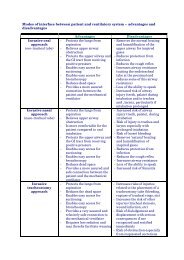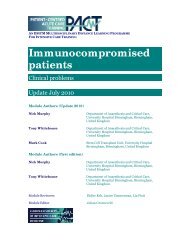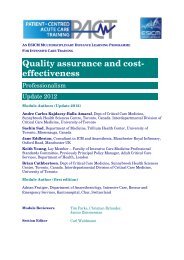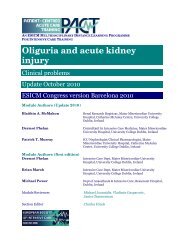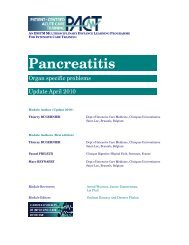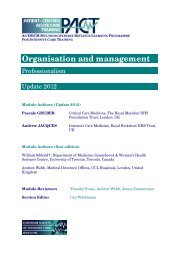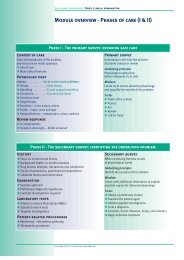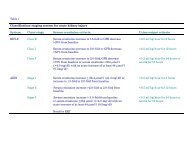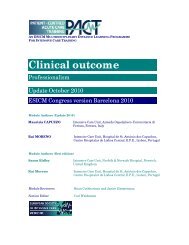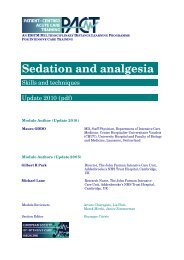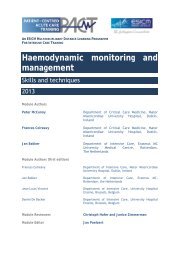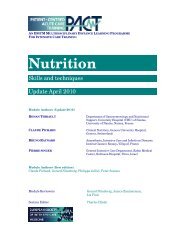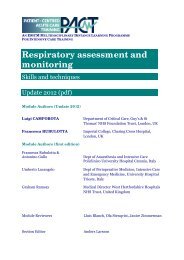Pyrexia - PACT - ESICM
Pyrexia - PACT - ESICM
Pyrexia - PACT - ESICM
You also want an ePaper? Increase the reach of your titles
YUMPU automatically turns print PDFs into web optimized ePapers that Google loves.
Acute acalculous cholecystitis<br />
Task 2. Determining the cause of fever in the critically ill patient<br />
After multiple trauma, burns, severe sepsis and major surgery, the gallbladder<br />
may become inflamed in the absence of gall stones. This inflammation, called<br />
acalculous cholecystitis, has an estimated incidence of 1.5% especially in septic<br />
patients or in patients recovering from abdominal sepsis. The low incidence is<br />
probably because of the non-specific clinical signs (pain in the right upper<br />
quadrant and nausea) and laboratory work-up. The detected wall thickness >3<br />
mm, intramural lucencies, gallbladder distension, pericholecystic fluid, and<br />
intramural sludge are helpful radiological findings while hepatobiliary<br />
scintigraphy is characterised by a high false-positive rate (>50%). Frequently,<br />
the diagnosis is delayed and the disease progresses to ischaemia, gangrene and<br />
perforation, indicating the necessary high index of suspicion while the<br />
treatment of choice is cholecystectomy. However, in very unstable patients,<br />
radiologic percutaneous drainage (cholecystostomy) may be preferred as a<br />
temporary measure and has replaced surgical cholecystectomy as a first choice<br />
treatment in many centres. In many patients, antibiotics will be prescribed,<br />
aimed at the causative organism, identified after percutaneous puncture and<br />
culture of the bile. For further details see:<br />
Boland G, Lee MJ, Mueller PR. Acute cholecystitis in the intensive care unit. New<br />
Horiz 1993; 1(2): 246–260. PMID 7922407<br />
Barie PS, Fischer E. Acute acalculous cholecystitis. J Am Coll Surg 1995; 180(2):<br />
232–244. PMID 7850064<br />
Other causes<br />
Be aware of central nervous system infections in patients with (internal or<br />
external) neurosurgical monitoring or draining devices. Coagulase-negative<br />
staphylococci are often involved. Suspected infection should prompt obtaining<br />
cerebrospinal fluid (CSF) for Gram stain and culture.<br />
Pseudomembranous colitis caused by Clostridium difficile has become a<br />
prevalent problem in many ICUs. In milder forms of the infection, diarrhoea<br />
may be the only feature. C. difficile -related diarrhoea is a relatively frequent<br />
occurrence in the critically ill, particularly if there has been treatment with<br />
multiple courses of broad-spectrum antibiotics. More severe forms of the<br />
disease are frequently characterised by a marked leukocytosis and elevated<br />
creatinine. Occasionally, an acute abdomen may result from C. difficile infection<br />
and surgical colectomy may be required. More virulent strains causing severe<br />
disease have recently emerged.<br />
The bacteria can be transmitted from patient to staff and vice<br />
versa, so that inadequate handwashing (alcohol gel is<br />
inadequate and soap and water is required for spore removal)<br />
may result in small outbreaks in the ICU. The diagnosis is<br />
established by a positive faecal toxin A and B (or tissue culture<br />
cytotoxicity) assays and increased faecal leukocytes. A negative<br />
[26]<br />
Rigorous attention to<br />
simple hygienic measures<br />
in the ICU is imperative.<br />
Alcohol hand cleansing is<br />
regarded as inadequate<br />
to clear C diff spores; a<br />
(traditional) physical<br />
handwash is required



